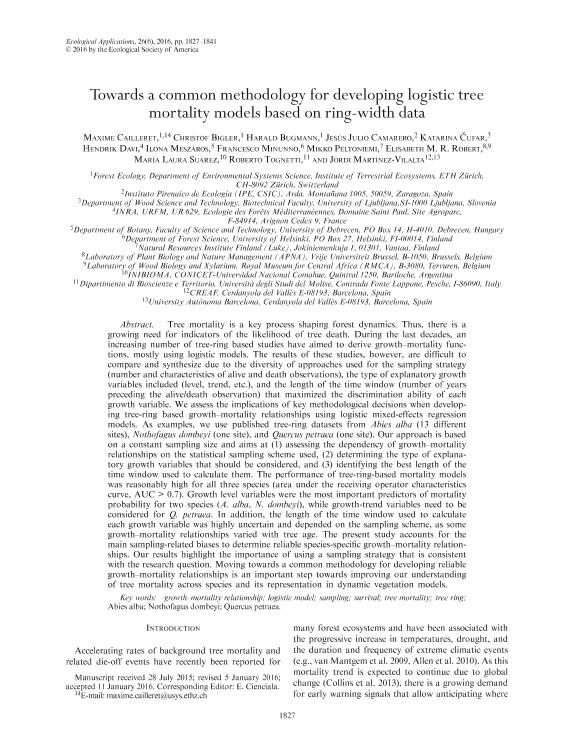Mostrar el registro sencillo del ítem
dc.contributor.author
Cailleret, Maxime
dc.contributor.author
Bigler, Christof

dc.contributor.author
Bugmann, Harald
dc.contributor.author
Camarero, Jesús
dc.contributor.author
Čufar, Katarina
dc.contributor.author
Davi, Hendrik
dc.contributor.author
Mészáros, Ilona
dc.contributor.author
Minunno, Francesco
dc.contributor.author
Peltoniemi, Mikko
dc.contributor.author
Robert, Elizabeth
dc.contributor.author
Suarez, Maria Laura

dc.contributor.author
Tognetti, Roberto
dc.contributor.author
Martínez Vilalta, Jordi
dc.date.available
2020-05-04T18:35:04Z
dc.date.issued
2016-09
dc.identifier.citation
Cailleret, Maxime; Bigler, Christof; Bugmann, Harald; Camarero, Jesús; Čufar, Katarina; et al.; Towards a common methodology for developing logistic tree mortality models based on ring-width data; Ecological Society of America; Ecological Applications; 26; 6; 9-2016; 1827-1841
dc.identifier.issn
1051-0761
dc.identifier.uri
http://hdl.handle.net/11336/104170
dc.description.abstract
Tree mortality is a key process shaping forest dynamics. Thus, there is a growing need for indicators of the likelihood of tree death. During the last decades, an increasing number of tree-ring based studies have aimed to derive growth–mortality functions, mostly using logistic models. The results of these studies, however, are difficult to compare and synthesize due to the diversity of approaches used for the sampling strategy (number and characteristics of alive and death observations), the type of explanatory growth variables included (level, trend, etc.), and the length of the time window (number of years preceding the alive/death observation) that maximized the discrimination ability of each growth variable. We assess the implications of key methodological decisions when developing tree-ring based growth–mortality relationships using logistic mixed-effects regression models. As examples, we use published tree-ring datasets from Abies alba (13 different sites), Nothofagus dombeyi (one site), and Quercus petraea (one site). Our approach is based on a constant sampling size and aims at (1) assessing the dependency of growth–mortality relationships on the statistical sampling scheme used, (2) determining the type of explanatory growth variables that should be considered, and (3) identifying the best length of the time window used to calculate them. The performance of tree-ring-based mortality models was reasonably high for all three species (area under the receiving operator characteristics curve, AUC > 0.7). Growth level variables were the most important predictors of mortality probability for two species (A. alba, N. dombeyi), while growth-trend variables need to be considered for Q. petraea. In addition, the length of the time window used to calculate each growth variable was highly uncertain and depended on the sampling scheme, as some growth–mortality relationships varied with tree age. The present study accounts for the main sampling-related biases to determine reliable species-specific growth–mortality relationships. Our results highlight the importance of using a sampling strategy that is consistent with the research question. Moving towards a common methodology for developing reliable growth–mortality relationships is an important step towards improving our understanding of tree mortality across species and its representation in dynamic vegetation models
dc.format
application/pdf
dc.language.iso
eng
dc.publisher
Ecological Society of America

dc.rights
info:eu-repo/semantics/openAccess
dc.rights.uri
https://creativecommons.org/licenses/by-nc-sa/2.5/ar/
dc.subject
TREE MORTALITY
dc.subject
GROWTH
dc.subject
LOGISTIC MODEL
dc.subject
TREE RING
dc.subject
SAMPLING
dc.subject
SURVIVAL
dc.subject.classification
Ecología

dc.subject.classification
Ciencias Biológicas

dc.subject.classification
CIENCIAS NATURALES Y EXACTAS

dc.title
Towards a common methodology for developing logistic tree mortality models based on ring-width data
dc.type
info:eu-repo/semantics/article
dc.type
info:ar-repo/semantics/artículo
dc.type
info:eu-repo/semantics/publishedVersion
dc.date.updated
2020-03-20T13:43:05Z
dc.identifier.eissn
1939-5582
dc.journal.volume
26
dc.journal.number
6
dc.journal.pagination
1827-1841
dc.journal.pais
Estados Unidos

dc.journal.ciudad
Washington DC
dc.description.fil
Fil: Cailleret, Maxime. Swiss Federal Institute of Technology Zurich; Suiza
dc.description.fil
Fil: Bigler, Christof. Swiss Federal Institute of Technology Zurich; Suiza
dc.description.fil
Fil: Bugmann, Harald. Swiss Federal Institute of Technology Zurich; Suiza
dc.description.fil
Fil: Camarero, Jesús. Consejo Superior de Investigaciones Científicas; España
dc.description.fil
Fil: Čufar, Katarina. University of Ljubljana; Eslovenia
dc.description.fil
Fil: Davi, Hendrik. Institut National de la Recherche Agronomique; Francia
dc.description.fil
Fil: Mészáros, Ilona. University of Debrecen. Faculty of Science and Technology. Department of Botany; Hungría
dc.description.fil
Fil: Minunno, Francesco. University of Helsinki; Finlandia
dc.description.fil
Fil: Peltoniemi, Mikko. Natural Resources Institute Finland; Finlandia
dc.description.fil
Fil: Robert, Elizabeth. Vrije Unviversiteit Brussel; Bélgica. Royal Museum for Central Africa. Laboratory of Wood Biology and Xylarium; Bélgica
dc.description.fil
Fil: Suarez, Maria Laura. Consejo Nacional de Investigaciones Científicas y Técnicas. Centro Científico Tecnológico Conicet - Patagonia Norte. Instituto de Investigaciones en Biodiversidad y Medioambiente. Universidad Nacional del Comahue. Centro Regional Universidad Bariloche. Instituto de Investigaciones en Biodiversidad y Medioambiente; Argentina
dc.description.fil
Fil: Tognetti, Roberto. Università degli Studi del Molise; Italia
dc.description.fil
Fil: Martínez Vilalta, Jordi. Consejo Superior de Investigaciones Científicas. Centre de Recerca Ecológica I Aplicacions Forestals; España. Universitat Autònoma de Barcelona; España
dc.journal.title
Ecological Applications

dc.relation.alternativeid
info:eu-repo/semantics/altIdentifier/doi/http://dx.doi.org/10.1890/15-1402.1
dc.relation.alternativeid
info:eu-repo/semantics/altIdentifier/url/https://esajournals.onlinelibrary.wiley.com/doi/abs/10.1890/15-1402.1
Archivos asociados
